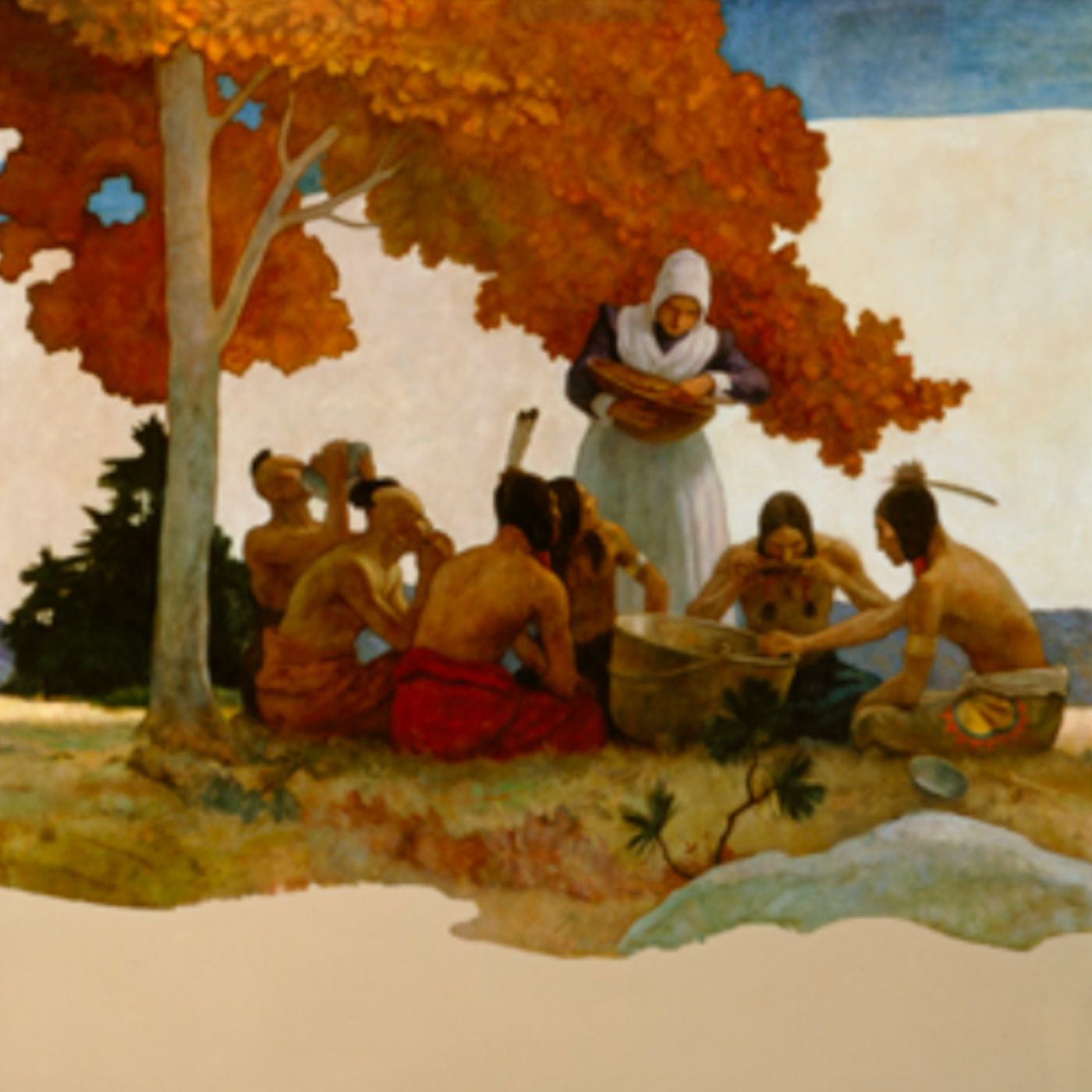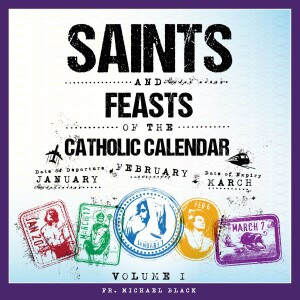
November 23, 2023: Fourth Thursday in November: Thanksgiving Day (U.S.A.)
 2023-11-22
2023-11-22
Download
Right click and do "save link as"
Fourth Thursday in November: Thanksgiving Day (U.S.A.)
Optional Memorial; Liturgical Color: White
Life is a gift replete with countless gifts
It’s 1542, and the Spanish Franciscan Juan de Padilla, a rugged ex-soldier, is trekking through the high, waving prairie grasses of the buffalo plains of North America at the head of a small band of explorers. Suddenly, an Indian war party of the Kansas people appears on the low horizon. The Spaniards scatter into the tall grasses for cover. But Father Padilla stays, slowly kneels in the moist soil, bows his head in prayer, and doesn’t move an inch. The war party approaches, and as the Spaniards watch from afar, they stretch their bows and fill Father Padilla’s torso with a volley of arrows. He is the first North American martyr. There are no dissenting Protestants anywhere in sight.
It’s 1570, and five Spanish Jesuits establish a mission, with chapel and school, to evangelize Indians in the future state of Virginia. In February of 1571, all the Jesuits are hacked to death with the very axes they had given to the Indians for chopping wood. A relief boat arriving a few months later finds Indians on the shore dressed in blood-stained cassocks. The English Potestant settlement of Jamestown is still thirty-six years in the future!
It’s April 30, 1598, in modern-day New Mexico. A Spanish explorer and a team of Franciscan priests erect a large cross and solemnly consecrate the vast land before them to Christ the King. The local Indians accept baptism and a large banquet is held, and is still held annually, to commemorate the event. The pilgrims who would one day land in Massachusetts are, in 1598, still in Europe. Throughout the American borderlands, in the Southwest, Florida, Georgia, Virginia, and Texas, hundreds of Spanish missionaries in the 1500s were traversing the deserts, swamps, forests, and plains of the future United States of America saying Mass, teaching the faith, and baptizing, long before a single boat loaded with pilgrims ever slowly floated into an East Coast harbor.
The people of the future United States of America gave thanks in many and varied ways long before President Abraham Lincoln, in 1863, established the last Thursday of November “as a day of Thanksgiving and Praise to our beneficent Father who dwelleth in the Heavens.” North America’s native tribes gave thanks in primitive ways common to all pre-modern societies. They honored the gods who formed the mountains like clay, who blew the winds across the prairies, and who caused the rain to fall. These Indians had their sacred dances, sacred dress, and sacred places where their holy men invoked the spirit gods equated with creation. These robust, but primitive, religious impulses lacked an equivalent moral dimension requiring respect for women, prisoners of war, children, or the unknown other. Christian missionaries brought a fuller, more complex religion which built a solid structure on the native culture’s wide base of nature-based cosmologies.
When dissenting Protestants disembarked in Massachusetts in 1620, they brought a deep belief in Jesus Christ and in His written word. After numerous settlers perished from disease, hardship, and starvation, they bonded with local Indians to offer thanks to God in 1621 for their tenuous survival. We need not live in desperate and difficult circumstances to fall to our knees in thanks to God for our life and all of its bounty. The intentional disciple must have a permanent attitude of gratitude if she finds it easy to believe when others struggle, if both of her parents were present as she grew up, if the children are healthy, if the job pays well, if the pain in the stomach was nothing at all, if the plane lands safely every time, if the bruised marriage heals, if there is always food at hand, gas in the car, a friend to call, or just one person who wonders where you’ve been the last few hours.
There’s a million reasons to be thankful and a million ways to express those million reasons. President Lincoln did not explain why he chose a Thursday as Thanksgiving Day, but perhaps the legacy of Catholicism influenced his decision. Jesus Christ instituted the Holy Eucharist, the ultimate act of Thanksgiving, on a Thursday evening—Holy Thursday. For the Catholic who goes to daily Mass, every day is Thanksgiving Day.
God, creation is not just a forum for action but a gift to mankind, a place for men and women, alone created in Your image and likeness, to work out their salvation, to exercise their gifts, and to render due homage and thanks to You for life itself, the gift of all gifts.
view more
Optional Memorial; Liturgical Color: White
Life is a gift replete with countless gifts
It’s 1542, and the Spanish Franciscan Juan de Padilla, a rugged ex-soldier, is trekking through the high, waving prairie grasses of the buffalo plains of North America at the head of a small band of explorers. Suddenly, an Indian war party of the Kansas people appears on the low horizon. The Spaniards scatter into the tall grasses for cover. But Father Padilla stays, slowly kneels in the moist soil, bows his head in prayer, and doesn’t move an inch. The war party approaches, and as the Spaniards watch from afar, they stretch their bows and fill Father Padilla’s torso with a volley of arrows. He is the first North American martyr. There are no dissenting Protestants anywhere in sight.
It’s 1570, and five Spanish Jesuits establish a mission, with chapel and school, to evangelize Indians in the future state of Virginia. In February of 1571, all the Jesuits are hacked to death with the very axes they had given to the Indians for chopping wood. A relief boat arriving a few months later finds Indians on the shore dressed in blood-stained cassocks. The English Potestant settlement of Jamestown is still thirty-six years in the future!
It’s April 30, 1598, in modern-day New Mexico. A Spanish explorer and a team of Franciscan priests erect a large cross and solemnly consecrate the vast land before them to Christ the King. The local Indians accept baptism and a large banquet is held, and is still held annually, to commemorate the event. The pilgrims who would one day land in Massachusetts are, in 1598, still in Europe. Throughout the American borderlands, in the Southwest, Florida, Georgia, Virginia, and Texas, hundreds of Spanish missionaries in the 1500s were traversing the deserts, swamps, forests, and plains of the future United States of America saying Mass, teaching the faith, and baptizing, long before a single boat loaded with pilgrims ever slowly floated into an East Coast harbor.
The people of the future United States of America gave thanks in many and varied ways long before President Abraham Lincoln, in 1863, established the last Thursday of November “as a day of Thanksgiving and Praise to our beneficent Father who dwelleth in the Heavens.” North America’s native tribes gave thanks in primitive ways common to all pre-modern societies. They honored the gods who formed the mountains like clay, who blew the winds across the prairies, and who caused the rain to fall. These Indians had their sacred dances, sacred dress, and sacred places where their holy men invoked the spirit gods equated with creation. These robust, but primitive, religious impulses lacked an equivalent moral dimension requiring respect for women, prisoners of war, children, or the unknown other. Christian missionaries brought a fuller, more complex religion which built a solid structure on the native culture’s wide base of nature-based cosmologies.
When dissenting Protestants disembarked in Massachusetts in 1620, they brought a deep belief in Jesus Christ and in His written word. After numerous settlers perished from disease, hardship, and starvation, they bonded with local Indians to offer thanks to God in 1621 for their tenuous survival. We need not live in desperate and difficult circumstances to fall to our knees in thanks to God for our life and all of its bounty. The intentional disciple must have a permanent attitude of gratitude if she finds it easy to believe when others struggle, if both of her parents were present as she grew up, if the children are healthy, if the job pays well, if the pain in the stomach was nothing at all, if the plane lands safely every time, if the bruised marriage heals, if there is always food at hand, gas in the car, a friend to call, or just one person who wonders where you’ve been the last few hours.
There’s a million reasons to be thankful and a million ways to express those million reasons. President Lincoln did not explain why he chose a Thursday as Thanksgiving Day, but perhaps the legacy of Catholicism influenced his decision. Jesus Christ instituted the Holy Eucharist, the ultimate act of Thanksgiving, on a Thursday evening—Holy Thursday. For the Catholic who goes to daily Mass, every day is Thanksgiving Day.
God, creation is not just a forum for action but a gift to mankind, a place for men and women, alone created in Your image and likeness, to work out their salvation, to exercise their gifts, and to render due homage and thanks to You for life itself, the gift of all gifts.
More Episodes
November 11: Saint Martin of Tours, Bishop
 2024-11-11
2024-11-11
 2024-11-11
2024-11-11
November 4: Saint Charles Borromeo, Bishop
 2024-11-04
2024-11-04
 2024-11-04
2024-11-04
November 1: All Saints
 2024-10-29
2024-10-29
 2024-10-29
2024-10-29
October 28: Saints Simon and Jude, Apostles
 2024-10-24
2024-10-24
 2024-10-24
2024-10-24
October 23: Saint John of Capistrano, Priest
 2024-10-23
2024-10-23
 2024-10-23
2024-10-23
October 22: Saint John Paul II, Pope
 2024-10-22
2024-10-22
 2024-10-22
2024-10-22
October 18: Saint Luke, Evangelist
 2024-10-18
2024-10-18
 2024-10-18
2024-10-18
012345678910111213141516171819
Create your
podcast in
minutes
- Full-featured podcast site
- Unlimited storage and bandwidth
- Comprehensive podcast stats
- Distribute to Apple Podcasts, Spotify, and more
- Make money with your podcast
It is Free
- Privacy Policy
- Cookie Policy
- Terms of Use
- Consent Preferences
- Copyright © 2015-2024 Podbean.com





